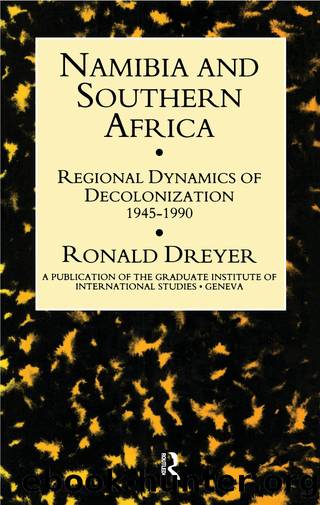Namibia Southern Africa by Dreyer

Author:Dreyer [Dreyer]
Language: eng
Format: epub
Tags: Social Science, Anthropology, General, Regional Studies
ISBN: 9781317848301
Google: -LAWDAAAQBAJ
Publisher: Routledge
Published: 2016-04-29T05:09:19+00:00
Destabilization of Angola
When the Reagan administration presented the linkage idea to the South African government in June 1981, 'Pretoria immediately seized upon this handy new delaying issue'.20 For in the past. South Africa had never made the Cuban withdrawal from Angola a precondition for its acceptance of the UN settlement plan for Namibia. Linkage provided a justification for delaying UN supervised elections, and for strengthening an anti-SWAPO, and pro-South African power structure in Namibia. The military thought a Cuban withdrawal from Angola would never take place.21 Linkage thus provided an additional pretext for perpetuating the occupation of Namibia, and intensifying attacks on Angola.
At the same time as seizing on the linkage issue, the South African military reverted to open destabilization of the region after Pretoria's idea of a Constellation of Southern African States had collapsed in the wake of Zimbabwean independence, and the formation of SADCC. In August 1981, the SADF mounted their biggest military operation since Angola's independence. During 'Operation Protea', more than 5,000 South African troops occupied all the main towns in the Cunene province in the southwest of Angola for several weeks. Angolan government troops (FAPLA) were able to stop the South African advance 110 km north of the Namibian border. But several thousand South African troops continued to occupy a 70 km wide strip in the southern Cunene province.22 This led to a quasi permanent occupation until end of August 1988, only briefly interrupted in 1985.
Officially presented as a preemptive strike against SWAPO, and the installation of a Soviet built early warning radar system and ground-to-air missiles, 'Operation Protea' illustrated two important features of the Total National Strategy as applied to Angola. Unlike the destabilization of other southern African states, where South Africa either supported dissident groups - the Mozambique National Resistance Movement (MNR or RENAMO), and the Lesotho Liberation Army (LLA)23 - or staged commando raids, South African forces were engaged in conventional warfare with Angolan troops.
In addition to direct intervention, South Africa also supported UNITA which it had helped to rebuild, and to reinstal itself in the southeast of Angola in 1980. In particular, it enabled the men of Savimbi to take Mavinga which became UNITA's forward base, and later a central target for several offensives by FAPLA. This in turn provided the South African military with the pretext to intervene inside Angola in defence of UNITA from 1985, UNITA forces had been trained by the SADF inside Namibia since 1976,24 and they relied on SADF rear bases for logistical support which had been reported in 1977, and which started on a large scale in late 1978 or early 1979.25 In addition to supporting UNITA, Pretoria also relied on the Buffalo or 32 Battalion, the special counterinsurgency force which had been created in 1976, and which consisted of former followers of FNLA, and mercenaries. Supported by the 54 Paratroop Battalion, and South African Air Force squadrons based at Ondangwa in northern Namibia, the 32 Battalion operated almost exclusively inside Angola, in the Cunene province in particular, where it became notorious for its atrocities against the civilian population.
Download
This site does not store any files on its server. We only index and link to content provided by other sites. Please contact the content providers to delete copyright contents if any and email us, we'll remove relevant links or contents immediately.
The European History Highway: A Guide to Internet Resources by Dennis A. Trinkle Scott A. Merriman(494)
The Seven Wonders of the Ancient World by Michael Denis Higgins(477)
European Security in a Global Context by Thierry Tardy(470)
European Security without the Soviet Union by Stuart Croft Phil Williams(469)
The Routledge companion to Christian ethics by D. Stephen Long Rebekah L. Miles(458)
Hudud Al-'Alam 'The Regions of the World' - a Persian Geography 372 A.H. (982 AD) by V. V. Minorsky & C. E. Bosworth(399)
Gorbachev And His Generals by William C. Green(391)
Get Real with Storytime by Julie Dietzel-Glair & Marianne Crandall Follis(390)
Tibetan Studies in Comparative Perspective by Chih-yu Shih Yu-Wen Chen(385)
Governance, Growth and Global Leadership by Espen Moe(381)
Hyperculture by Byung-Chul Han(378)
CliffsNotes on Fitzgerald's The Great Gatsby by Kate Maurer(360)
The Oxford History of the World by Fernández-Armesto Felipe;(354)
How Languages Are Learned 5th Edition by Patsy M Lightbown;Nina Spada; & Nina Spada(353)
The Egyptian Economy, 1952-2000 by Khalid Ikram(352)
Oral Poetry and Narratives from Central Arabia: The Poetry of Ad-Dindan : A Bedouin Bard in Southern Najd (Studies in Arabic Literature, Vol 17) (English and Arabic Edition) by P. M. Kupershoek P. Marcel Kurpershoek(344)
The Oxford Handbook of the Incas by Sonia Alconini(333)
Europe Contested by Harold James(319)
The Hutchinson Dictionary of Ancient and Medieval Warfare by Peter Connolly John Gillingham John Lazenby(305)
